Glitter, glue and physics too Teach article
Explore physics in a new way by creating a model of particle collisions using craft materials.
If you consider the type of equipment needed for practical activities in a physics classroom, you might think of prisms, crocodile clips or data loggers. Science, and especially physics, is often perceived as different and difficult, with complicated equipment and machines; it’s done in a special place, a laboratory, and it has a language all of its own, with many technical words. However, doing practical work with everyday items can help engage students by giving them a different perspective on the subject.
In this article we introduce an activity using art materials. We originally designed it to be used at public events, like festivals and science fairs, but the mix of creativity and science proved to be a lot of fun for participants of all ages, and teachers who saw their enthusiasm were keen to replicate this enjoyment in the classroom.
Crafting collisions
Researchers often use models to explain phenomena and observations, but these are still just theoretical ideas and only described in words, or perhaps pictures. Using simple craft materials to represent some physical aspect of a process or object can be an excellent way to develop an understanding of abstract concepts. Hands-on activities can also engage students who may otherwise lose interest in what they perceive as a dry, academic subject.
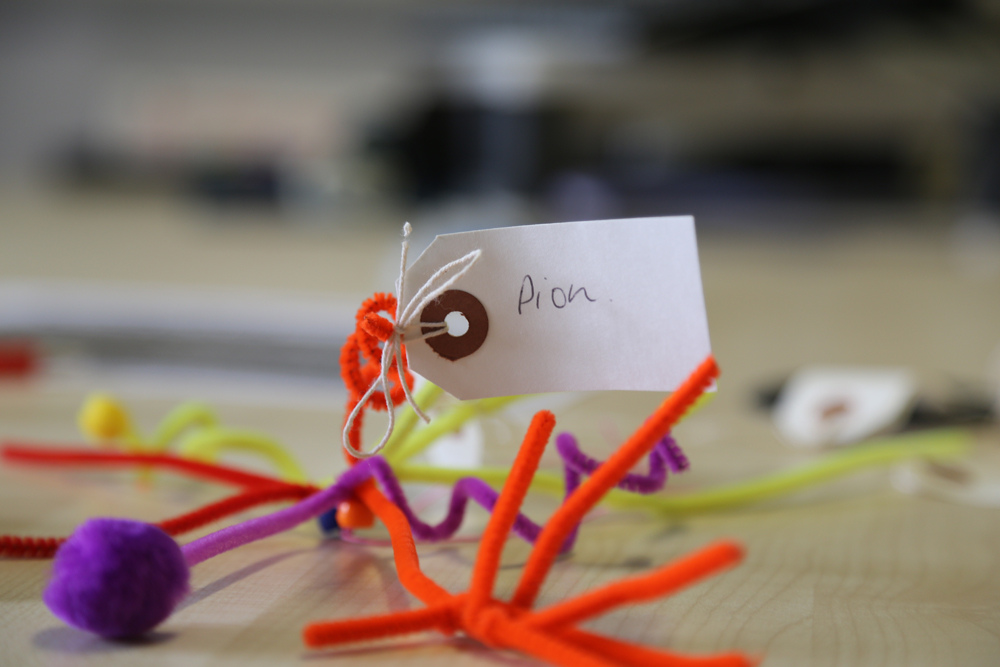
Creative activities in the science classroom are appealing because of their novelty. Unusual activities create ‘situational interest’ – a temporary interest that is triggered spontaneously by the external environment, for example through curiosity or enjoyment (Schraw et al, 2001). Stimulating these reactions in the classroom is a way of hooking students’ attention and getting them to think.
This activity addresses subatomic particle physics and how scientists establish knowledge in this fieldw1. It can help students to learn about and understand the standard model of particle physics and the search for the Higgs boson at the Large Hadron Collider (LHC) at CERN. The activity does not create much mess and can be done in a reasonably compact space. It works well with secondary school students but also appeals to older primary school pupils (although the concept of sub-atomic particles may be very new and challenging for them).
The basics of subatomic particles
First discuss the basics of subatomic particles. What is all matter made of? What is inside an atom, a proton and a neutron? Everything around us, from galaxies, the Earth, even ourselves, is made of atoms. Despite the fact that we cannot see them by eye, atoms are not the smallest level of matter. Atoms themselves are composed of tiny particles, which in turn are made of tinier particles that group together, and so on… and we still do not know where it finishes.
That is one of the reasons why scientists are still exploring what comprises atoms: what forces keep the particles linked and whether there are more particles to be discovered. One way that scientists have to explore atoms is by smashing particles together at almost at the speed of light using particle accelerators like those at CERN. Ask your students what they think might happen when particles are smashed together very quickly.
Such collisions may break down atoms into their constituent particles, or existing particles may fuse to create bigger particles. These may resemble what existed millions of years ago at the beginning of the Universe when all its matter and energy were concentrated in a tiny space. Scientists can observe the pattern of the particles produced by a collision and use this to determine what they are by the way they move. Analysing the debris from particle collisions, therefore, allows scientists to identify what new particles have been produced. See Landua 2008a and Landua 2008b for more details of how particle accelerators work and how they can help scientists understand the origin of the Universe and what it is made of.
Creating a particle collision mobile
In this activity, students create a model depicting the products created when two particles are smashed together in a particle accelerator. The particles will be represented by coloured beads, their trajectories by pipe cleaners, and the products of the collision by pom-poms. In this way, the craft model will help the students to visualise the normally abstract world of particle physics.
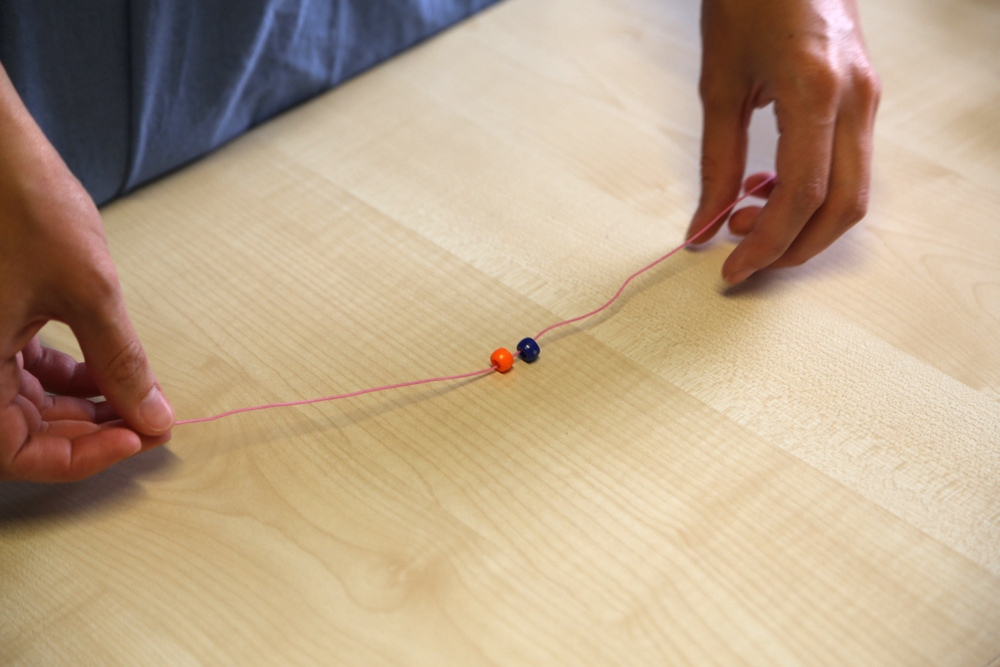
Institute of Physics
Materials
- Coloured elastic thread (about 20 cm)
- Coloured beads
- Pipe cleaners
- Pom-poms
- Paper tags
- Glue
- Scissors
Procedure
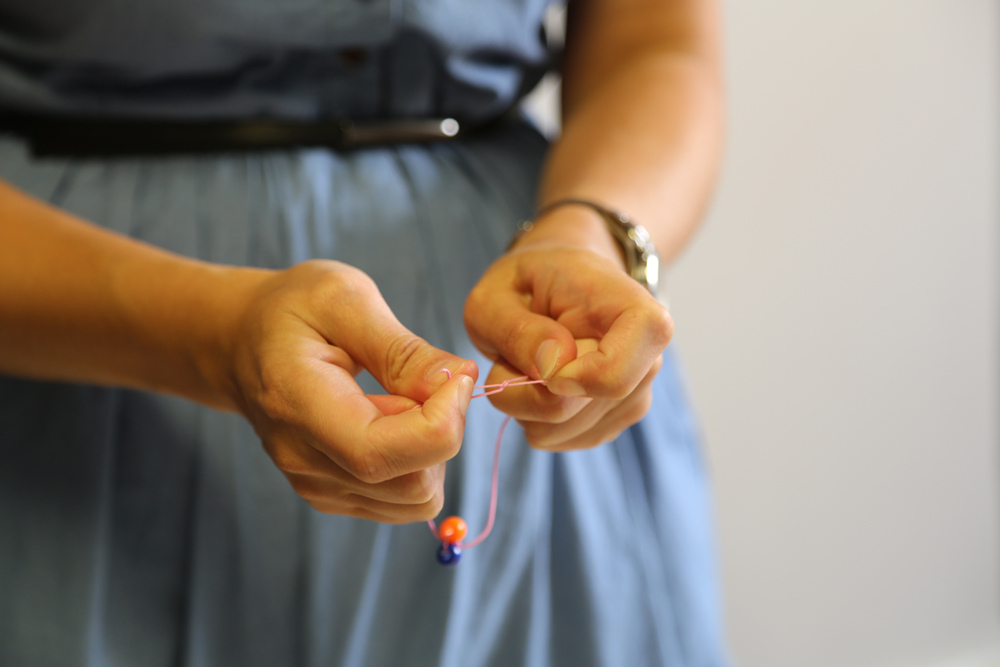
Institute of Physics
- Thread two beads onto the elastic thread. These beads represent the colliding particles.
- Using the elastic thread, tie a double knot around the beads. Tie another knot towards the ends of the elastic so you have a large loop.
- Push several pipe cleaners through the small elastic loop and around the beads.
- Bend the pipe cleaners in half around the small loop of elastic, then twist the strands together.
- Shape the ends of the pipe cleaners into particle tracks.
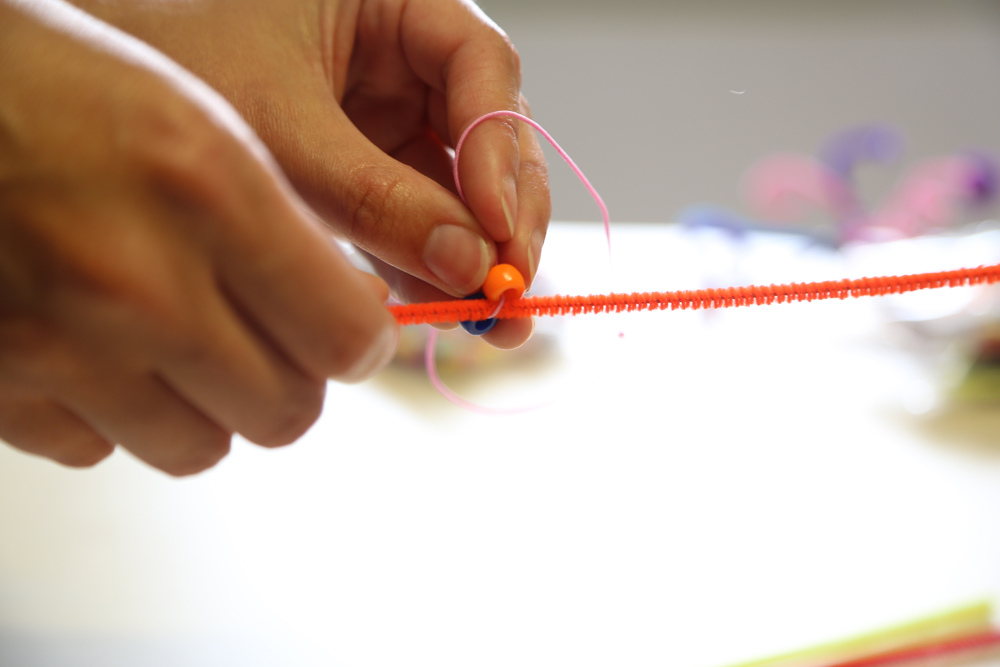
Institute of Physics
Explain to your students why different particles follow different paths depending on their energy, charge and mass. Lighter particles have longer tracks while heavy particles have shorter tracks. The tracks of charged particle are curved, whereas neutral (uncharged) particles travel in straight lines. Particles with low energy follow spiral paths. Some particles may even follow branched paths.
Show your students a couple of examples and then let them discover the remaining types once they have finished building their mobile.
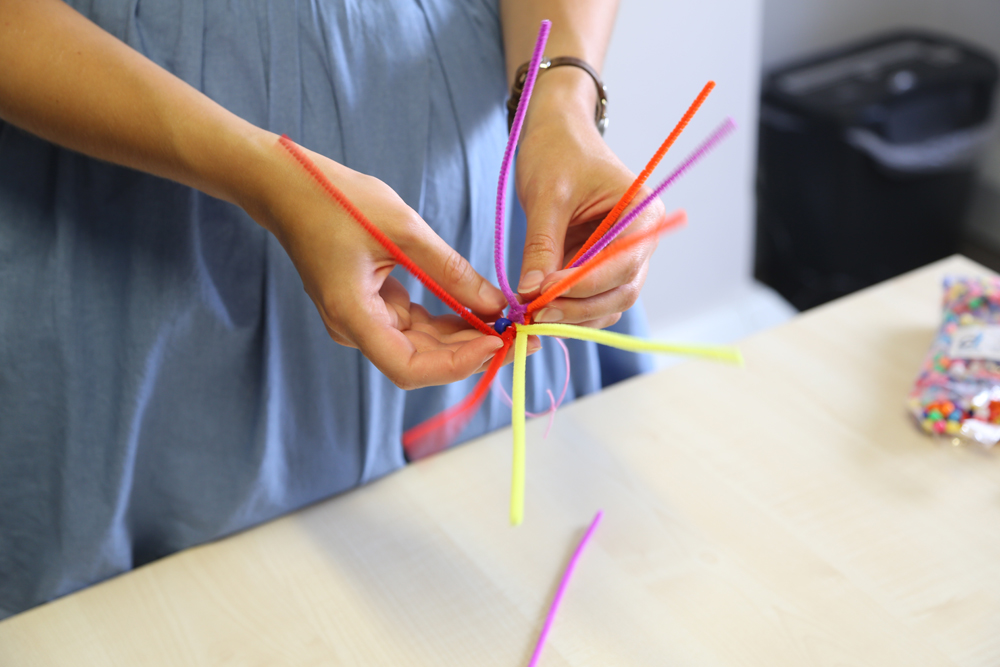
- Fix pom-poms to the end of the pipe cleaners using glue or by curling the pipe cleaners round the pom-poms.
Put results together: has anyone ‘found’ the Higgs Boson?
The last step in creating the particle mobile is to attach labels to the particles. To guide the labelling, provide the students with something similar to table 1, which specifies the exact trajectories of each particle type.
| Trajectory | Particle | Description |
|---|---|---|
| Long straight tracks | Photon | Pure energy |
| Short straight tracks | Neutrino or anti-neutrino | Small and light |
| Long curved tracks | Muon or anti-muon | Larger and charged |
| Short curved tracks | Electron or positron | Smaller and charged |
| Spiral tracks | Pion | An up-down quark pair |
| Jets (tracks starting together and then branching out) | Quark pairs and gluons
Z-bosons and W-bosons |
Gluons stick quarks together
Heavy particles that carry force |
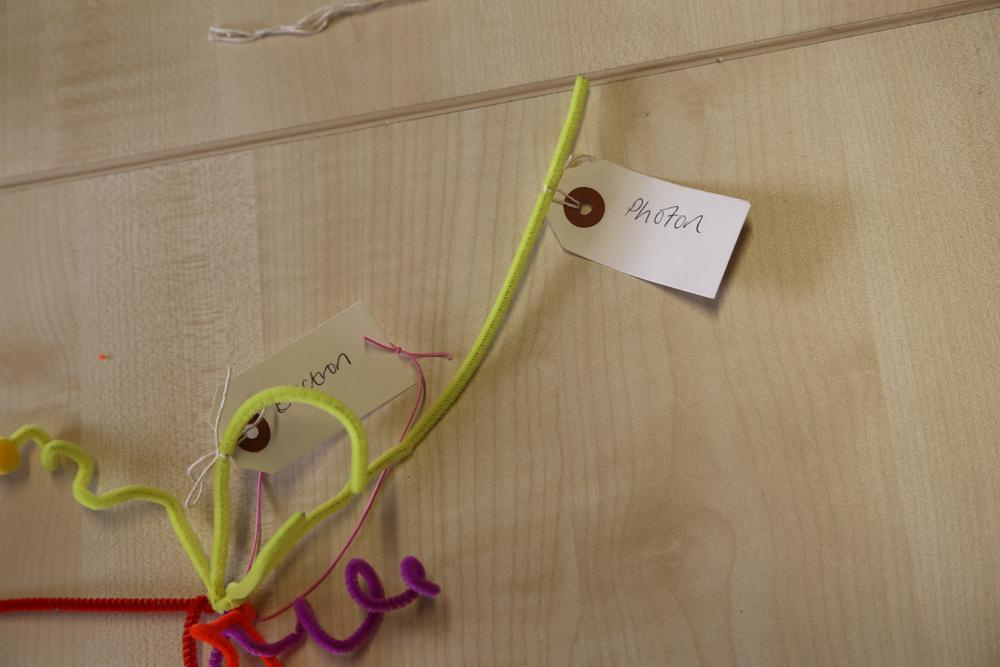
Once the students have added the labels to the particles in their models, discuss the different types of particles they have made. Perhaps they came up with a trajectory that does not appear in the table. If so, you can discuss what happens in particle accelerator experiments when new trajectories are found. Ask the students to give a name to their newly discovered particle.
Now that students have made the subatomic particles visible, you can extend the discussion, for example to cover what the Higgs boson is (see Hayes, 2012).
Teaching science through craft
The finished pieces can be displayed in the classroom or around the school to highlight the topic of particle physics to the school community, in the same way that artwork is exhibited publicly. Alternatively, students can take their creations home to prompt discussions about science with their families. The models are also easy to replicate should your students wish to show their parents or siblings how to make them too.
These craft activities make excellent outreach demonstrations, for example at a school open evening or science fair. Students can demonstrate the activities to their peers, younger children or visitors. This is an excellent opportunity to boost students’ confidence and communication skills and allow them to share an enthusiasm for science.
An evaluation of the activity when used with the public (Durbin, 2011) showed that the combination of craft-based creativity with facilitated discussion results in increased understanding and interest. Similarly, in the classroom, allowing students to use their own imagination when exploring a topic captures their interest and helps them to understand it. Above all, by making the abstract more comprehensible, the wonder of science can be shared and enjoyed by everyone.
Acknowledgement
The author would like to thank the Institute of Physics and Samantha Durbin who helped develop and test the activities.
References
- Durbin S (2011) Creative Physics: Evaluating a series of craft-based physics activities. University of the West of England, UK, MSc Dissertation.
- Hayes E (2012) Accelerating the pace of science: interview with CERN’s Rolf Heuer. Science in School 25: 6–12.
- Landua R (2008) The LHC: a look inside. Science in School 10: 34–45.
- Landua R, Rau M (2008) The LHC: a step closer to the Big Bang. Science in School 10: 26–33.
- Schraw G, Flowerday T, Lehman S (2001) Increasing situational interest in the classroom. Educational Psychology Review 13: 211–224
- This article is freely available online.
Web References
- w1 – Instruction leaflets about this and two additional craft activities exploring galaxies and planets can be found on the Institute of Physics website. The three activities are suitable for a wide range of ages and do not require any pre-existing ability. The science behind the activities involves topics that are regularly in the news and still being actively researched, providing an opportunity to make links with real-world physics.
Resources
- Further pictorial instructions on the particle physics model can be found on the Physics.org website.
- To learn more about CERN and the search for the Higgs boson, visit the CERN education site where you will find lesson plans and resources on particle physics.
- To build your own particle accelerator, see:
- Brown A, Merkert J, Wilson R (2014) Build your own particle accelerator. Science in School 30: 21–26.
- Continue your students’ interest in these topics with citizen science projects from the Zooniverse, which enable your students to discover their own Higgs boson using real scientific data.
- Some simple learning strategies to promote situational interest in the classroom can be found here.
Review
This article presents a practical activity aimed at exploring high-energy collisions between particles. A model of visualising beam collisions and new particle creation is presented through pipe cleaner and pom-pom mobiles. This activity can be easily prepared and carried out in a classroom with pupils aged 10–15, but it will also be of interest during school or science fairs for participants within the same age range. The required materials are cheap and readily available and the instructions are easy to follow (but read them twice!). This is a golden opportunity to introduce particle physics – and why not Feynman diagrams – from a qualitative standpoint. The leaflet available onlinew1 will be very useful, and a visit to www.HiggsHunters.org is strongly encouraged!
Davide Vité, Cycle d’orientation de Cayla, Geneva, Switzerland





